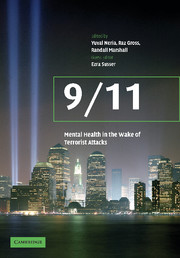Book contents
- Frontmatter
- Contents
- Acknowledgments
- Editors brief bio
- List of contributors
- Foreword
- Part I Introduction
- Part II The psychological aftermath of 9/11
- Part III Reducing the burden: community response and community recovery
- Part IV Outreach and intervention in the wake of terrorist attacks
- Part IV A New York area
- Part IV B Washington, DC
- 24 The mental health response to the 9/11 attacks on the Pentagon
- 25 Learning lessons from the early intervention response to the Pentagon
- Part IV C Prolonged-exposure treatment as a core resource for clinicians in the community: dissemination of trauma knowledge post-disaster
- Part V Disasters and mental health: perspectives on response and preparedness
- Index
25 - Learning lessons from the early intervention response to the Pentagon
from Part IV B - Washington, DC
Published online by Cambridge University Press: 27 October 2009
- Frontmatter
- Contents
- Acknowledgments
- Editors brief bio
- List of contributors
- Foreword
- Part I Introduction
- Part II The psychological aftermath of 9/11
- Part III Reducing the burden: community response and community recovery
- Part IV Outreach and intervention in the wake of terrorist attacks
- Part IV A New York area
- Part IV B Washington, DC
- 24 The mental health response to the 9/11 attacks on the Pentagon
- 25 Learning lessons from the early intervention response to the Pentagon
- Part IV C Prolonged-exposure treatment as a core resource for clinicians in the community: dissemination of trauma knowledge post-disaster
- Part V Disasters and mental health: perspectives on response and preparedness
- Index
Summary
Ritchie and colleagues should be congratulated for their work at the Pantagon on and after September 11, 2001, for their useful and rich depiction of that horrific day, and its aftermath, and for the various mental health activities provided to victims, the traumatically bereaved, first responders, and graves registration personnel. In order to appreciate the demands placed on Ritchie and colleagues, any mental health professional need only to ask themselves what they would have done on 9/11, and what they are prepared to do if a mass violence event were to occur in their work setting or vicinity and they are called on to plan, implement, or assist in providing mental health services to victims, workers, and their families. There is no doubt that mental health professionals, public health officials, and individuals responsible for planning disaster mental health and terrorism responses in employee assistance programs and various work systems and organizations have much to gain by absorbing the information provided by Ritchie and colleagues.
The authors describe the enormous difficulties and exigencies of deriving a working, good-enough mental health response plan that would be amenable or tolerable to the military culture, and to the unique work culture at the Pentagon for civilians and families of employees and military personnel directly and indirectly exposed to the attack on 9/11. The decisions made about resources, the content and process of the interventions provided, and who and where they would provide them were arguably about as good as could be expected, given the state of knowledge in disaster mental health and the unprecedented nature of 9/11 terror.
- Type
- Chapter
- Information
- 9/11: Mental Health in the Wake of Terrorist Attacks , pp. 446 - 454Publisher: Cambridge University PressPrint publication year: 2006



